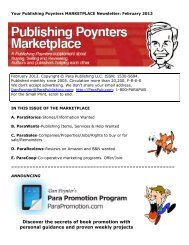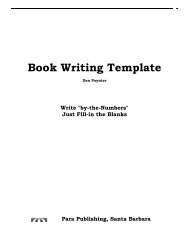P-47 WN-Book Writing Layout Template - Para Publishing
P-47 WN-Book Writing Layout Template - Para Publishing
P-47 WN-Book Writing Layout Template - Para Publishing
You also want an ePaper? Increase the reach of your titles
YUMPU automatically turns print PDFs into web optimized ePapers that Google loves.
L<strong>Book</strong> <strong>Writing</strong> <strong>Template</strong>—page 32Everyone Judges a <strong>Book</strong> by its CoverAnd what you can do about itike it or not, no one reads the book before he or she makes a buyingdecision. Consumers do not read it in the store. Sales reps only carrybook covers and jackets to show store buyers while wholesalers anddistributors say “just send us the cover copy.” All buying decisions are made onthe illustration/design and the sales copy on the outside of the book. Yes,packaging is everything.Each year, U.S. industry spends more than $50 billion on package design.Now, that is not $50 billion for the packages and certainly not for the contents.That money is for the design of the packages. Packages prompt buyers toreach for the product whether it is pantyhose, corn flakes or hair spray.Focus on who your audience is and what they want. Think: about who areyou talking to and what are they going to get from the book.You will discover:• (benefit)• (benefit)• (benefit)• (benefit)Stores have tens-of-thousands of books being displayed spine-out. With all thiscongestion, it is hard to get attention. Initially, all a potential buyer sees is thebook’s spine. If the browser takes it down, he or she will gaze at the coverabout four seconds and the flip it over to read the back cover. On average, heor she will spend just seven seconds here so the trick is to keep them readinglonger. Your copy has to be punchy and benefit-laden; it has to speak to thepotential buyer.Your book cover designer will lay out the package and incorporate theillustration, put it all on disk and send it to your printer but you must draft thesales copy. This book cover worksheet will take you step-by-step through thesales-copy draft process. Use your computer so you will be able to move thecopy around once entered.5. Testimonials and endorsements. Dream up three differentendorsements from people you would like to quote. If This book changedmy diplomatic strategy.—Colin Powell, would look good, try it. Use namesor titles recognizable in your field—sources that might impress potentialbuyers. This is just a draft; dress it up. You will secure some of thesequotations later.6. Show the author is the ultimate authority on the subject. Just two orthree sentences will do.7. End with a sales closer in bold type. Ask the book-browser to buy thebook. Use something like This book has enabled thousands to . . . and itwill show you the way too.Drafting ad copy is hard work. Ad-copy writers, people who write ads for aliving, need to stimulate their imagination. Most of them study the fieldconstantly. When they see an element of an ad they like in a magazine or online, they will pull it out, circle the good part and put it in a “swipe file.” Whenthey are commissioned to write and ad, they will go through the swipe filelooking for ideas. You can use the same stimulating procedure but they is aneasier, more direct way to do it.Look for two to four other books at Amazon that are very close to your book.Think to yourself, if someone were to buy that book, would they be a goodcandidate to buy your book?Print out the multiple pages. Highlight the buzzwords and good bookdescriptions. Now, spread out the page and draft your sales copy. All the good,descriptive sales copy is in front of you. The highlighting will stimulate yourcopy-writing imagination and make the drafting easy.Here are explanations for each area of the outline.A. Front cover. Select a working title and subtitle. Keep the title short andmake the subtitle descriptive.List the most important person in your field (association or industry) for theforeword (and please note the spelling of Foreword.) You will try to get them topen the foreword later.8. Price. <strong>Book</strong>stores like a price on the book. The price is a turn-off topotential buyers so place it at the end of the sales copy. Never locate theprice at the top of the back cover. If this is a hardcover book, place theprice at the top of the front flap.9. Bar code with International Standard <strong>Book</strong> Number (ISBN). The barcode on a book identifies the ISBN, which in turn identifies the publisher,title, author and edition (hardcover, etc.). Make room for, but do not worryabout, the bar code and ISBN just now.Your title, subtitle, back-cover headline and benefits may be swapped. Onceyou have them written down, you may wish to move some of them around.Perhaps one of your benefits would be a better subtitle.Most back cover copy is weak and uninspiring. The title is repeated and then isfollowed by several quotations and a bar code and that’s it! Haphazard copy isthe sign of lazy (and maybe inexperienced) copywriter. This lack of effectivecompetition on the shelf gives us the upper hand.<strong>Book</strong> cover illustrations and design have improved tremendously over the past20 years. Author/publishers used to spend all their efforts on the text and thecover became an afterthought. Some publishers remember it was RobertHoward who brought bright, insightful, relevant, remarkable covers to theindustry. There are many great cover designers today and it was RobertHoward who started it all.B. Spine. Stack the title on the spine so it will read more easily on the shelf.Use a bold, san-serif, vertically-legged typeface such as Arial Black, bolded.A good cover artist will read through your book and create a cover that willreflect the message of the text. The cover and text should match.C. Back cover.1. Category. Visit a bookstore and check the shelf where your book will bedisplayed. Note the categories on the books and the shelves. Listing thecategory on the back cover of your book will insure your book will be easyto find—because the bookshop personnel will place it on the right shelf.2. Now you need an arresting headline addressed to potential buyers. Youwant them to relate to the book and find themselves in it. Do not repeat thetitle here; do not bore the potential buyer. You have already “said it” on thefront. Use an alternate approach. For example, The Self-<strong>Publishing</strong>Manual’s back-cover headline is Why Not Publish Yourself?3. Sales copy. Concisely (two to four sentences) state what the book isabout. What will the reader gain by reading this book?4. Bulleted promises or benefits. Promise to make readers better at whatthey do. Pledge health, wealth, entertainment or a better life. Be specific.Years ago, we said “Write your ad before you write your book.” This was tohelp you focus on who you were writing to and what you were going to givethem. Then we realized the most important ad you will ever write is your backcover copy. Now we say: “Write your cover copy before you write your book.”Packages sell products and covers sell books. Give your books the opportunityin the marketplace they deserve. Package your text to quickly tell the idlebrowser what is inside.Editor’s note: Dan Poynter is the author of more than 130 books. He is bestknown for The Self-<strong>Publishing</strong> Manual (16 revised editions in 35 years). In theback of that book, he asks readers to send their book once published; hereceives 15 to 20 books each week! He says that cover art is improving but thesales copy still needs work on many of them. See http://<strong>Para</strong>Pub.com © 2012,Dan Poynter.
















